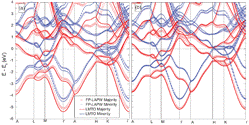Department of Physics and Astronomy: Publications and Other Research

Kirill Belashchenko Publications
Document Type
Article
Date of this Version
2014
Citation
PHYSICAL REVIEW B 90, 214108 (2014)
Abstract
The harmonic Kanzaki-Krivoglaz-Khachaturyan model of strain-induced interaction is generalized to concentrated size-mismatched alloys and adapted to first-principles calculations. The configuration dependence of both Kanzaki forces and force constants is represented by real-space cluster expansions that can be constructed based on the calculated forces. The model is implemented for the fcc lattice and applied to Cu1−xAux and Fe1−xPtx alloys for concentrations x = 0.25, 0.5, and 0.75. The asymmetry between the 3d and 5d elements leads to large quadratic terms in the occupation-number expansion of the Kanzaki forces and thereby to strongly non-pairwise long-range interaction. The main advantage of the full configuration-dependent lattice deformation model is its ability to capture this singular many-body interaction. The roles of ordering striction and anharmonicity in Cu-Au and Fe-Pt alloys are assessed. Although the harmonic force constants defined with respect to the unrelaxed lattice are unsuitable for the calculation of the vibrational entropies, the phonon spectra for ordered and disordered alloys are found to be in good agreement with experimental data. The model is further adapted to concentration wave analysis and Monte Carlo simulations by means of an auxiliary multiparametric real-space cluster expansion, which is used to find the ordering temperatures. Good agreement with experiment is found for all systems except CuAu3 (due to the known failure of the generalized gradient approximation) and FePt3, where the discrepancy is likely due to the neglect of magnetic disorder.


Comments
©2014 American Physical Society